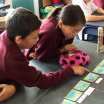Support social interaction
Develop learning activities and approaches to foster social interaction.
On this page:
On this page:
Current page section: Support social interaction
Go to top of current page: Support social interaction
Go to top of current page: Support social interaction
Go to top of current page: Support social interaction
Understand social norms, diversity and masking
Understand social norms, diversity and masking
Encourage and value diverse ways of interacting rather than expecting all learners to socialise in the same way.
For some students, pressure to adhere to social norms and mask or hide individual differences can cause anxiety, stress and exhaustion. Consider the ways that communication varies across cultures and contexts.
For example, eye contact may be an inappropriate social skills goal for some autistic people and people with anxieties. It is disrespectful in some cultures.
Appropriate social skills are those that support the individual’s strengths, needs, personal goals and values. Work with whānau and ākonga to identify appropriate goals.
Source: The Neurodivergent Guide to Socialising (opens in a new tab/window)
Target social skills teaching to needs
Target social skills teaching to needs
Sometimes students may need targeted teaching of social skills.
For example, autistic students often need specific teaching to learn how to initiate interactions, share, and take turns.
Steps to consider:
- Define social skills goals and values with the student and their team.
- Describe the goal in measurable terms.
- Use a range of teaching techniques, for example, structured discussions, social stories.
- Facilitate the generalisation of social skills to peers through role-playing and video modelling.
- Transition from structured teaching to everyday situations – the student may need supports to achieve this.
- Check for social validity – can the student use the new skills in different situations?
For resources and activity cards see the Health and Physical Education curriculum:
Social and Emotional Learning – Resource collections
For younger students see Te Whariki Online:
He Māpuna te Tamaiti – Supporting social and emotional competence in early learning
Source: LaMarca, V. ( Ed). Teaching social skills to children with autism. Lovaas Institute: Indianapolis.
Enrich learning with tuakana-teina relationships
Enrich learning with tuakana-teina relationships
Ākonga at Irongate School use a tuakana-teina approach where older or more expert Year 5 and 6 tuakana help and guide the younger or less expert new entrant tēina.
Create exemplars of social scenarios
Create exemplars of social scenarios
![11688 [Inviting-play.png]](https://inclusive-live-storagestack-assetstorages3bucket-3uty0hejzw6u.s3.ap-southeast-2.amazonaws.com/public/inclusive-education/example-images/Inviting-play__ScaleMaxWidthWzEwODZd.png)
Source: Ministry of Education | Te Tāhuhu o te Mātauranga
Foster collaboration and group work
Foster collaboration and group work
Celebrate diversity by providing opportunities for ākonga to work with others using their strengths. Carefully design group or pair activities to suit learners and maximise productive interactions.
Develop approaches that celebrate diverse learners:
- Encourage tuakana-teina relationships and create a culture where students provide support for each other.
- Develop cross-cultural communication skills, learning about how conventions for conversation vary across cultures and contexts.
- Teach specific speaking and conversation skills. For example, rehearse ways to start and close a conversation, and to keep the conversation flowing.
- Practise conversation skills, appropriate for students, such as maintaining personal space between people, using eye contact, facial expressions and taking turns.
- Assign group roles such as speaker, listener, and note-taker to group members.
- Provide strategies to help students to listen actively to each other, share ideas, and recognise different points of view. For example, thinking tools such as De Bono’s thinking hats.
- Create social stories that break down a task or social situation into small and easy-to-understand steps, accompanied by descriptive pictures.
- Monitor discussions to ensure all students understand the task and have opportunities to participate.
Next steps
More suggestions for implementing the strategy “Key areas to support”:
-
Current page Support social interaction
Return to the guide “Speech, Language and Communication”

Speech, Language and Communication
How to use this site
Guide to Index of the guide: Speech, Language and Communication
Strategies for action:
-
Identify needs and how to provide supportShow suggestions for Identify needs and how to provide support
-
Key areas to supportShow suggestions for Key areas to support
- Support understanding
- Develop expressive language
- Support social interaction
- Develop speech sounds
- Learn about stuttering and voice
- Support AAC users
-
Helpful classroom strategies years 1-8Show suggestions for Helpful classroom strategies years 1-8
-
Helpful classroom strategies years 9-13Show suggestions for Helpful classroom strategies years 9-13
